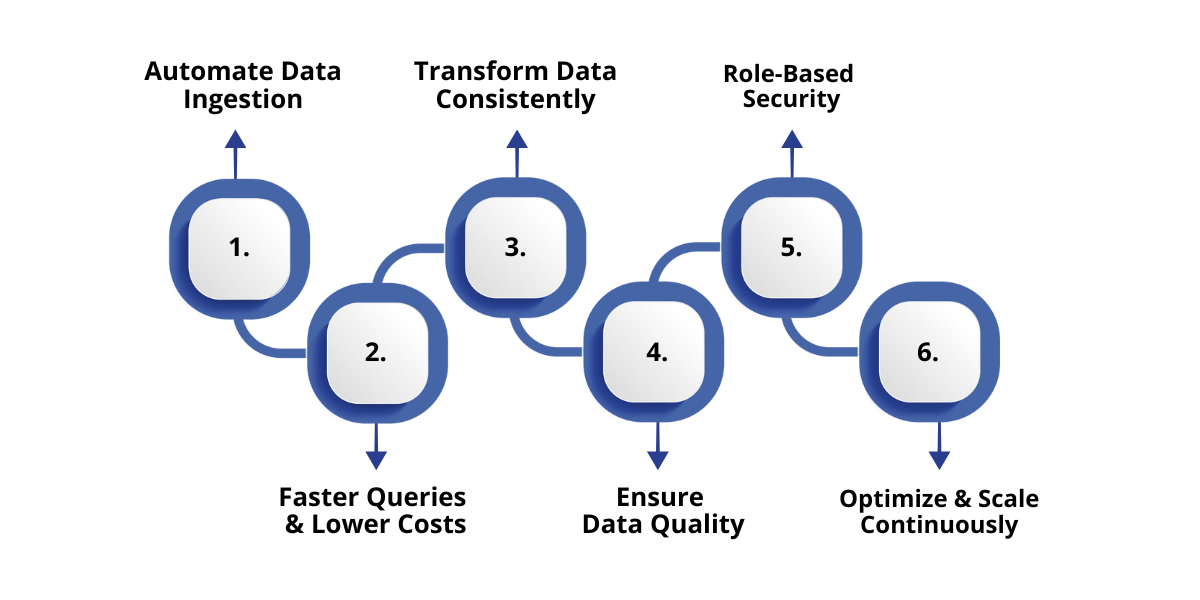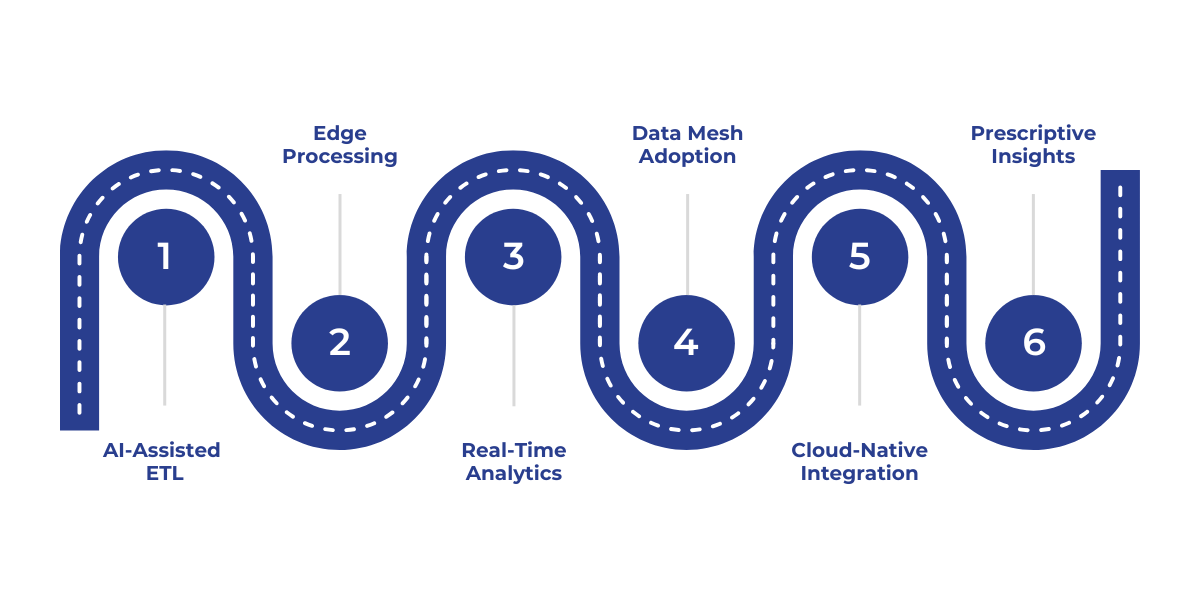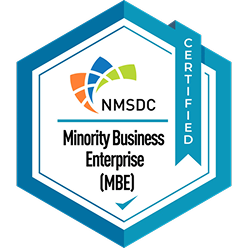

Frustrated with valuable data trapped in isolated systems, slowing decisions and growth? Organizations with integrated data are more likely to gain new customers. Microsoft Fabric makes this effortless, unifying engineering, storage, and analytics in a single platform with built-in ingestion, transformation, security, and governance.
This guide covers best practices for data transformation in Microsoft Fabric to help you scale efficiently, ensure accuracy, and maximize the value of your data.
Before implementing best practices, it’s essential to understand the business goals behind data transformation, so you know what success looks like before implementing solutions.

Data transformation in Microsoft Fabric ensures raw data aligns with your organization’s objectives. It converts fragmented inputs from multiple systems into structured, actionable outputs, supporting smarter business decisions.
Key goals include:
Once the goals are clear, it’s important to see how proper transformation directly influences analytics and decision-making.
Data transformation is critical to realizing the full potential of analytics in Microsoft Fabric. Without it, raw data remains fragmented, inconsistent, and unreliable, which can lead to flawed insights and poor business outcomes.
When implemented effectively:
To achieve reliable insights, we now explore the core best practices that make Microsoft Fabric data transformation effective.

A successful data transformation strategy ensures your organization can turn raw, fragmented data into actionable insights. Microsoft Fabric enables businesses to unify, clean, and prepare data at scale while supporting analytics, AI, and compliance.
Below are the key practices to implement.
The foundation of effective data transformation is capturing the right data quickly, reliably, and consistently. Automating ingestion and ETL/ELT workflows reduces errors, accelerates processing, and ensures downstream analytics deliver accurate, actionable insights.
Consider these key points as well:
Organizations using edge processing achieve faster data handling and better operational efficiency, while modern storage practices can reduce infrastructure costs by up to 60%.
Key practices include:
Also Read: Understanding the Benefits and Examples of Data Modernization Strategy
By consistently structuring and transforming data, organizations can ensure their analytics deliver accurate insights that drive meaningful, actionable decisions. and aligned with business needs.
Some key features include:
Consistent data transformation creates dependable analytics and supports effective decision-making across the organization.
High-quality data is the foundation of reliable dashboards, predictive models, and informed business decisions. Maintaining data integrity ensures analytics are trustworthy and actionable.
This strategy also includes:
Secure your sensitive data while empowering teams to access the insights they need to act fast and make informed decisions. Strong security measures protect compliance and strengthen trust across your organization.
Some more key points include:
Implementing role-based security keeps data protected and accessible, letting teams act confidently on accurate, governed information.
Also Read: Introduction to Microsoft Fabric for Small and Medium-Sized Enterprises
The strength of analytics operations lies in continuous monitoring of data pipelines. A clear connection between oversight and performance ensures efficiency, maintains accuracy, and keeps operations high-performing, enabling teams to act on insights quickly and maintain reliable analytics.
To sum it up:
Consistent monitoring of Microsoft Fabric's architecture and optimization guarantee that your analytics environment scales seamlessly while maintaining accuracy and timeliness.
Even with best practices in place, challenges arise. Let’s explore common hurdles and how to overcome them effectively.

Even with a robust platform like Microsoft Fabric, organizations face hurdles during data transformation that can impact Microsoft Fabric’s analytics accuracy, speed, and reliability.
For example, a retail enterprise reduced processing delays by 40% after standardizing schemas and implementing incremental loading, improving real-time reporting for over 200 stores.
Some key challenges and ways to overcome them include:
Different sources often use varying formats, leading to fragmented or inaccurate data.
Solution:
Massive volumes of data can slow processing and raise storage costs.
Solution:
Real-time insights may be delayed if pipelines are inefficient.
Solution:
By proactively addressing these challenges, organizations can ensure their data is accurate, actionable, and ready for decision-making.
Also Read: Setting Up and Using Copilot for Data Factory in Microsoft Fabric
Once challenges are managed, it’s essential to keep an eye on emerging trends shaping data transformation strategies.

As data volumes increase rapidly, businesses need faster, smarter, and cost-efficient transformation strategies to stay competitive.
Key trends include:
These trends ensure your data transformation strategy delivers accurate, actionable insights and positions your organization for sustainable growth and innovation.
Also Read: Thinking of Working with a Microsoft Fabric Partner? Here’s What to Expect
Implementing best practices for data transformation in Microsoft Fabric ensures accurate, reliable, and actionable analytics.
By applying strategies such as automated ETL workflows, optimized storage, incremental loading, and consistent data standards, organizations can improve query performance, reduce errors, and streamline operations.
At WaferWire, we provide expert support throughout your Microsoft Fabric data transformation journey, from initial setup to ongoing management. We help standardize processes, maintain data quality, and ensure scalable, high-performing analytics.
Contact us today to implement Microsoft Fabric data transformation practices that maximize efficiency and deliver trustworthy insights.
1. How can I ensure consistent and reliable data in Microsoft Fabric?
Implement standardized transformation rules, enforce schema consistency, and use incremental loading to process only new or updated data. This ensures clean, accurate, and analysis-ready datasets.
2. What are the best practices for optimizing storage in Microsoft Fabric?
Partition large datasets, merge small files, and use columnar storage formats like Parquet. These techniques reduce query latency, speed up transformations, and lower infrastructure costs.
3. How can I automate data transformation workflows?
Use Fabric Data Factory or low-code dataflows to schedule ETL/ELT pipelines. Automation reduces errors, accelerates processing, and ensures timely availability of transformed data.
4. How do I maintain data quality and reliability?
Use automated validation, proactive cleansing, and track data lineage to identify errors quickly. High-quality data ensures dashboards, AI models, and reports remain accurate and actionable.
5. How can I secure sensitive data during transformation?
Apply role-based access controls, dynamic data masking, and governance policies using Microsoft Fabric and Purview. This protects sensitive information while maintaining usability for analytics.
6. What tools can help monitor and optimize data transformation performance?
Track resource usage, query performance, and pipeline efficiency using Fabric monitoring tools. Continuous optimization ensures scalable, high-performing analytics operations.

